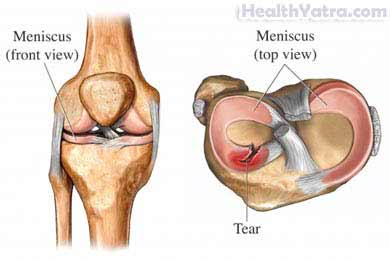Definition
A meniscal tear is a tear in the meniscus. The meniscus is cartilage, which acts as a shock-absorbing structure in the knee. There are two menisci in each knee, a medial one on the inside, and a lateral one on the outside.
There are different types of tears depending on the location and how they look. Treatment depends on the severity of the tear.

Causes
Most injuries to the meniscus are caused by trauma. This usually includes compression and twisting of the knee. Because aging tends to break down the inner tissues of the meniscus, minor trauma can injure the meniscus in an older person.
Risk Factors
Factors that may increase your risk of a meniscal tear include:
- Participating in contact sports
- Improper techniques for jumping, landing, pivoting, and cutting
- Increasing age
- Previous knee injuries
- Obesity
Symptoms
Symptoms may include:
- A popping sound at the time of the injury
- Pain and swelling in the knee
- Tightness in the knee
- Locking up, catching, or giving way of the knee
- Tenderness in the joint
Diagnosis
Your doctor will ask about your symptoms and your medical history. A physical exam will be done.
Tests may include:
- X-ray
- MRI—To get images of the internal structure of the knee.
- Arthroscopy—A thin, lighted tube inserted through a small incision in the knee to look at the structures inside the knee. With the arthroscope, the tear will be seen and may be removed or repaired as necessary.
Treatment
Talk with your doctor about the best treatment plan for you. Recovery time ranges depend on the severity of your injury. Treatment steps may include:
Acute Care
Rest
Your knee will need time to heal. Avoid activities that place extra stress on the knee:
- Do not do activities that cause pain. This includes running, jumping, and weight lifting using the legs.
- Do not play sports until your doctor has said it is safe to do so.
Your doctor may recommend a knee brace to stabilize the knee, and crutches to keep extra weight off your leg.
Cold
Apply an ice or a cold pack to the area for 15-20 minutes, four times a day, for several days after the injury. Do not apply the ice directly to your skin. Wrap the ice or cold pack in a towel.
Pain Relief Medications
To manage pain, your doctor may recommend:
- Over-the-counter medication, such as aspirin, ibuprofen, or acetaminophen
- Prescription pain relievers
Compression
Compression can help prevent more swelling. Your doctor may recommend an elastic compression bandage around your knee. Be careful not to wrap the bandage too tight.
Elevation
Elevation can also help keep swelling down. Keep your knee higher than your heart as much as possible for the first 24 hours or so. A couple of days of elevation might be recommended for severe sprains.
Recovery Steps
Heat
Use heat only when you are returning to physical activity. Heat may then be used before stretching or getting ready to play sports to help loosen the knee joint.
Stretching
When the acute pain is gone, start gentle stretching as recommended. Stay within pain limits. Hold each stretch for about 10 seconds and repeat six times. Stretch several times a day.
Strengthening
Begin strengthening exercises for your legs as recommended.
If you are diagnosed with a meniscal tear injury, follow your doctor’s instructions.
Surgery
Repair or removal of all or part of the damaged meniscus may by performed. This is usually done through small incisions of the skin. A camara and special tools are inserted through the incisions.
Prevention
To reduce your chances of a meniscal tears, take these steps:
- Maintain proper technique when exercising or playing sports.
- Wear appropriate footwear for your sport and playing surface.
- Strengthen both the quadriceps and the hamstrings.
- Consider wearing a knee brace for sports.
